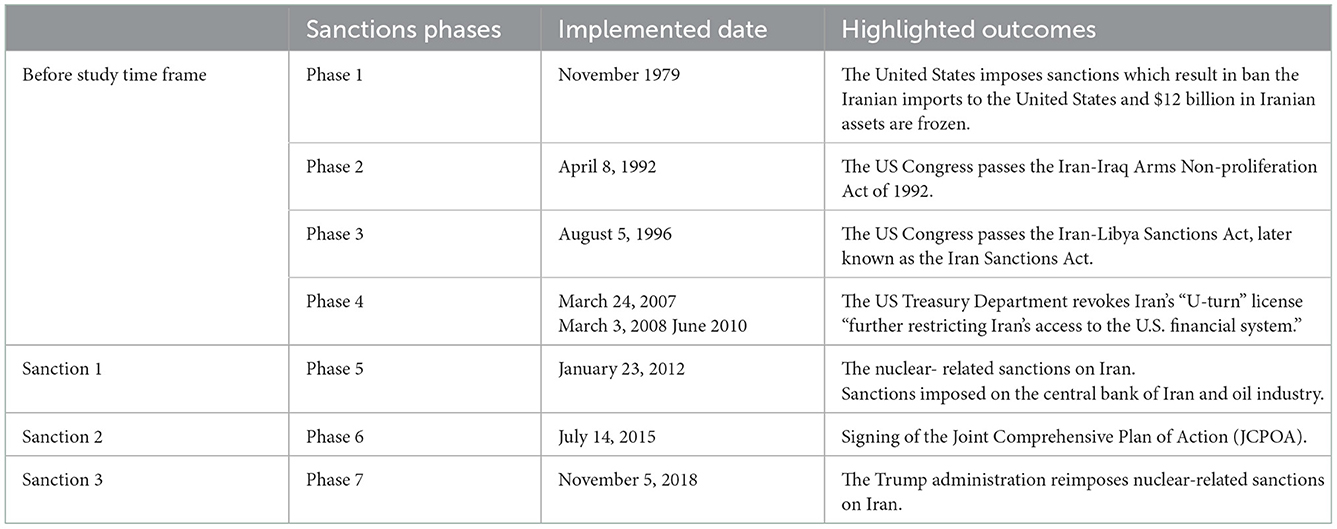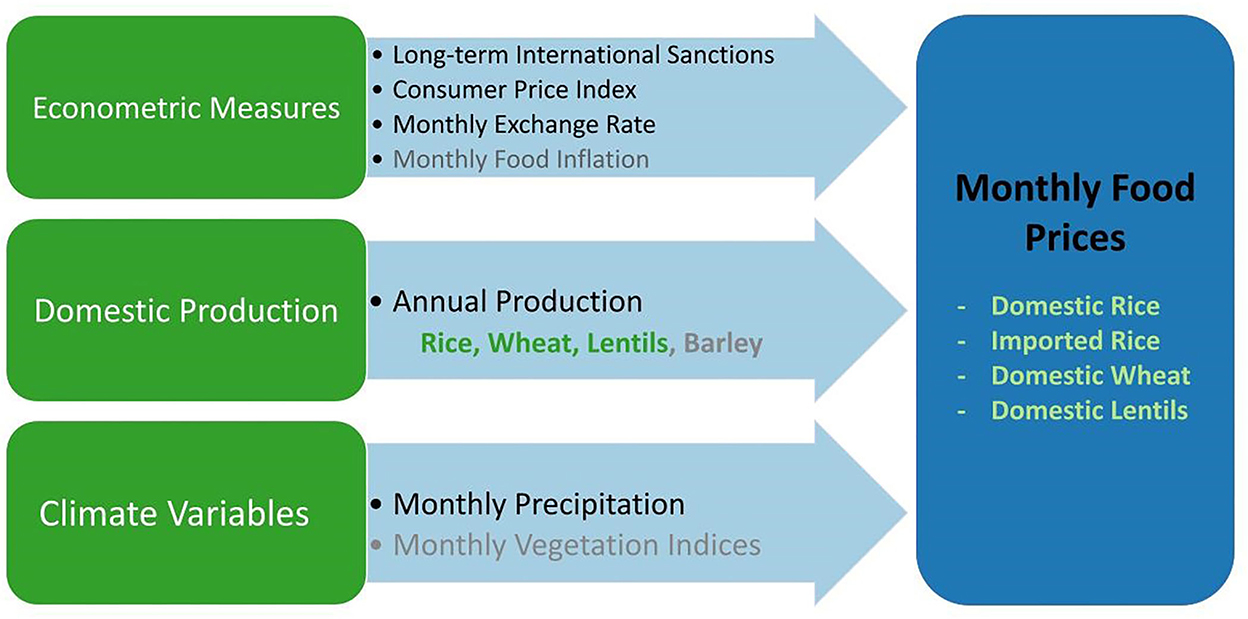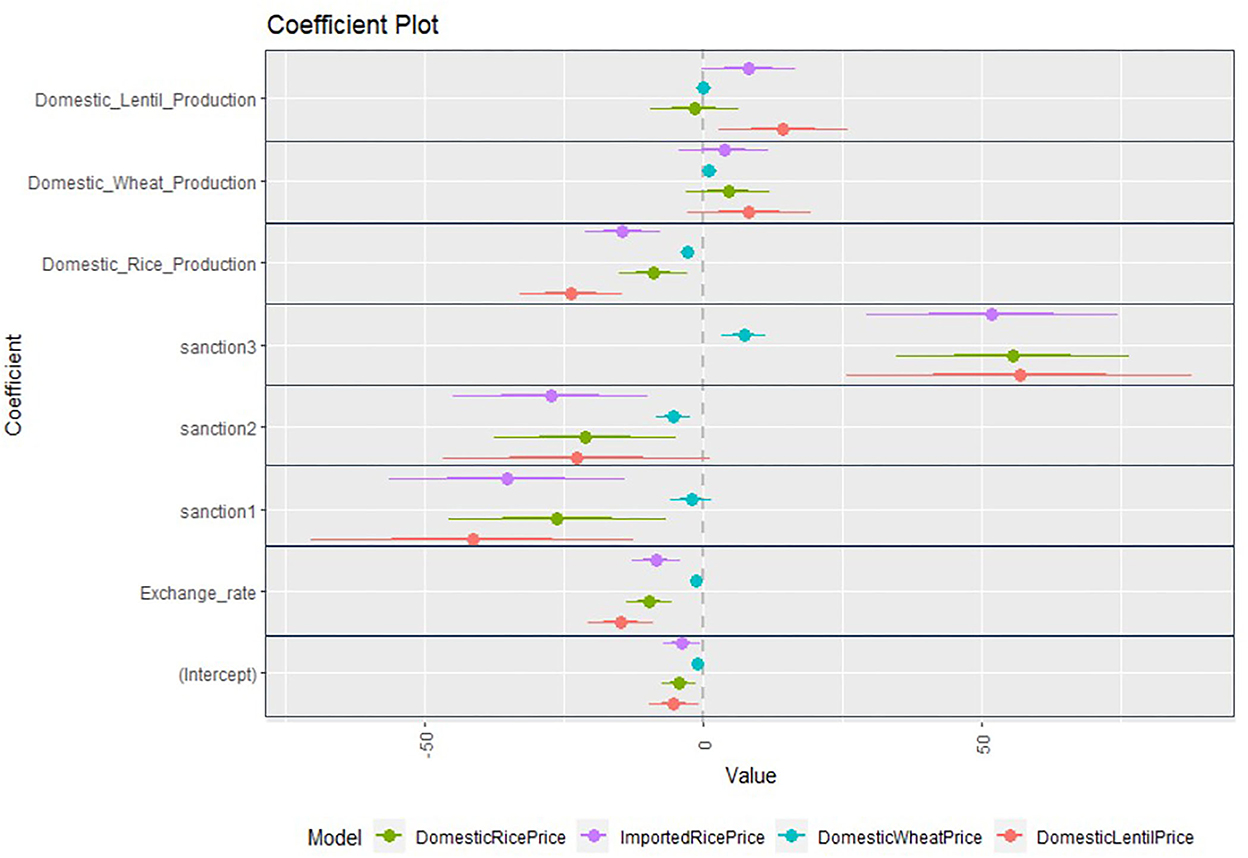- 1Department of Mechanical Engineering, University of California, Berkeley, Berkeley, CA, United States
- 2Department of Geography, Miami University, Oxford, OH, United States
- 3Department of Geographical Sciences, University of Maryland, College Park, MD, United States
- 4ISciences, L.L.C., Burlington, Vermont, United States
Introduction: The scarcity of resources have affected food production, which has challenged the ability of Iran to provide adequate food for the population. Iterative and mounting sanctions on Iran by the international community have seriously eroded Iran's access to agricultural technology and resources to support a growing population. Limited moisture availability also affects Iran's agricultural production. The aim of this study was to analyze the influence of inflation, international sanctions, weather disturbances, and domestic crop production on the price of rice, wheat and lentils from 2010 to 2021 in Iran.
Method: Data were obtained from the statistical yearbooks of the Ministry of Agriculture in Iran, Statistical Center of Iran, and the Central Bank of Iran. We analyzed econometric measures of food prices, including CPI, food inflation, subsidy reform plan and sanctions to estimate economic relationships. After deflating the food prices through CPI and detrending the time series to resolve the non-linear issue, we used monthly Climate Hazards group Infrared Precipitation with Stations (CHIRPS) precipitation data to analyze the influence of weather disturbances on food prices.
Results and discussion: The price of goods not only provides an important indicator of the balance between agricultural production and market demand, but also has strong impacts on food affordability and food security. This novel study used a combination of economic and climate factors to analyze the food prices in Iran. Our statistical modeling framework found that the monthly precipitation on domestic food prices, and ultimately food access, in the country is much less important than the international sanctions, lowering Iran's productive capability and negatively impacting its food security.
1. Introduction
Global food security is often noted as a prerequisite for sustainable development (FAO and WHO, 2019). Adequate supplies of food is a fundamental aspect of human societies, and is considered one of the pivotal factors of individual and social health (Tutunchi et al., 2020). In the last 10 years, the frequency and intensity of conflict, climate variability and extremes, and economic slowdowns have increased and are undermining food security and nutrition around the world (FAO, IFAD, UNICEF, WFP, and WHO, 2021). Of particular concern are low- and middle-income countries because the negative impacts on food security and nutrition are greatest in these countries (FAO, 2021b). Most of the world's undernourished, food insecure that suffer from one or more forms of malnutrition live in low-income countries (FAO, IFAD, UNICEF, WFP, and WHO, 2021). Findings of a systematic review and meta-analysis on climate and food prices by Birgani et al. (2022) show that increases in food price will significantly affect food accessibility in lower-income countries, primarily through 2050.
Iran is an upper middle-income country (FAO, IFAD, UNICEF, WFP, and WHO, 2021). Restrictions on imports and exports have generated hurdles for food transportation, while consumers and producers have faced difficulties that ultimately led to declining farmers' income, damaging the agricultural sector (FAO, 2020). The Food and Agriculture Organization of the United Nations (FAO) reports that from 2018 to 2020 the prevalence of moderate or severe food insecurity in the approximate total population of 84 million in Iran was 42.5%, with the prevalence of undernourishment at 5.5% (FAO, 2021a). Fiscal policies should promote the ability of households to meet their nutritional needs (Behzadifar et al., 2016). The scarcity of resources and lack of food production with high population growth are challenging the ability of the country to provide adequate food (Iran Economy News, 2021). Northern Iran is the most important domestic agricultural region, with the largest share of domestic food production (Sharifi, 2021). For the majority of the country, the climate is arid or semi-arid, with long-run average annual rainfall estimates ranging from 200 to 230 millimeters per year (The World Bank, 2021; World Bank, 2021) and therefore, local weather disturbances inevitably affect food markets, resulting in increased food prices (Mbow et al., 2019).
The purpose of this study was to explore the impact of precipitation anomalies and trade sanctions on food prices, and ultimately food security, in Iran. This 120-month, 10-year study of four commodity crops describes the impact of weather disturbances on food prices in the context of inflation, changes in the exchange rate and ongoing sanctions. The paper is organized by first describing the current economic situation in Iran, specifically the impact of trade sanctions on the country, inflation on food affordability, and current climate trends. We then present our data, the methods used in the analysis and our results. We finish with a discussion of the implications of climate and trade sanctions on agricultural productivity over a period of a decade. In the past decade, a few papers have analyzed the impact of climate and food prices in Iran separately (Karbasi and Sayyadi, 2015; Afzali et al., 2020; Kiani Ghalehsard et al., 2020; Fatahi Ardakani et al., 2022). In this study, we provide a novel analysis that seeks to include a wide range of variables related to the price of domestic commodity crops. The main study question is: to what extent are food prices impacted by the international sanctions, food inflation and climate change?
2. Background
2.1. Agriculture in Iran
Agriculture in Iran is one of the three main sectors of the economy, playing an important role in food supply, social welfare, and gross domestic product (GDP). Due to its extensive connections with other economic sectors, the agriculture sector provides the basis for wealth production, market creation and currency generation [Statistical Center of Iran (SCI)., 2019]. In Iran, rice has a special place in the daily diet. Many agricultural processing activities and supplementary industries (e.g., rice bran oil and rice hull factories) result from the rice crop (Mardani Najafabadi et al., 2022). The head of Agricultural Mechanization Development Center of the Ministry of Agriculture Jihad (hereafter referred to as the Ministry of Agriculture), emphasized that rice cultivation should be stopped in low-water provinces, allowing and promoting rice production in the Gilan and Mazandaran provinces of northern Iran (Iran Economy News, 2021). According to the Ministry of Agriculture-Jihad in Iran Yearbook (2019), Golestan Province (also in northern Iran) produces about 10% of the total wheat output with high quality as well as 14% of total rice production after Mazandaran and Gilan provinces. Therefore, northern Iran is the main region of producing domestic rice (~ 84% of domestic production providing by Mazandaran and Gilan provinces) and wheat (~ 14% of sharing domestic production is in Golestan province as well as the self-sufficiency in wheat production to meet the needs of Mazandaran province) and an important region of the country in terms of food security and food sovereignty (Zamanialaei et al., 2022). Figure 1 shows examples of pest management in wheat and barley fields (a) and a rice field (b) in northern Iran.
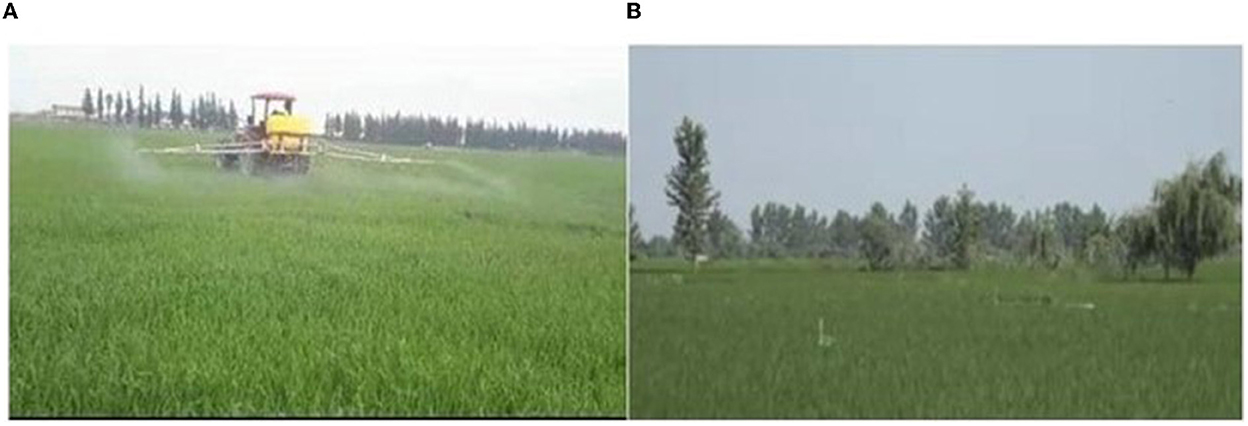
Figure 1. (A) Technology of pest management in wheat and barley fields in Golestan province (March 2022, Source: https://kesht-sanat.ir/?p=5219). (B) Rice farm in Amol, Mazandaran province (March 2017 by Maryam Zamanialaei).
2.2. Food inflation
Iran's economy has been trying to control its chronic inflation by creating discipline in monetary and fiscal policies (Zaroki and Yousefi-Barfurushi, 2021). In the past decade, inflationary pressures in Iran have been particularly high due to a limited supply of foreign exchange and economic uncertainty (The World Bank, 2021). Food inflation in Iran has averaged 22.88 percent from 2012 until 2021, reaching 59.20 percent in August of 2020 over the same month in the previous year (Figure 2) (Trading Economics., 2021). The inflation rate is the measure of the increase or rate of increase in the general price of selected goods and services over a determined period of time, and can indicate a decline in the purchasing power or value of a nation's currency (FEWS NET, 2009).
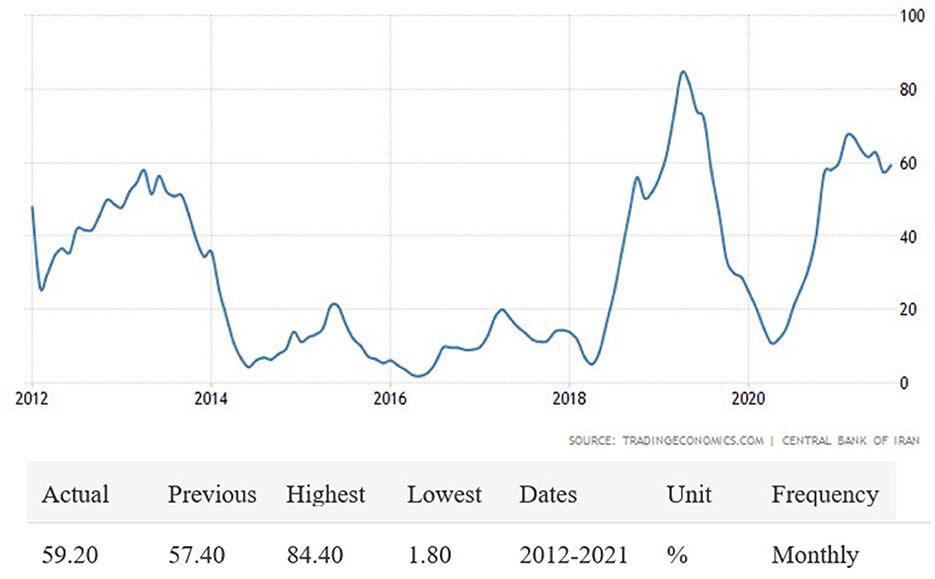
Figure 2. Monthly percentage of food inflation in Iran 2012–2021, with 2011 as the base year to calculate inflation rate (Source: Central Bank of Iran, www.cbi.ir).
Soaring food prices and subsidy cuts directly affected the food security situation among the poor and vulnerable population in Iran [World Food Programme (WFP)., 2016]. Both controlling the price of goods and monopoly pricing are severe problems for Iran's economy (Shakeri et al., 2015). Social safety nets, which included food and energy subsidies, have supported the food security of the population (Devereux, 2016). Iran passed a targeted subsidy plan in December 2010 (Persian: یارانهها هدفمندسازی طرح) also known as the subsidy reform plan, which replaces subsidies on food and fuel (80% of total) with targeted social assistance in accordance with a 5-year economic development plan (Salamatbakhsh, 2020). Unfortunately, like many other programs in the region, this targeted social assistance is low and inaccurately applied, resulting in far less support and leading to substantial food price inflation (Harrigan, 2014).
The latest official information available from Iran's Central Bank indicates that, in the period from 19 February 2019 to 20 March 2019 (corresponding to اسفند 1398), food and beverages price inflation index climbed to 72 percent on a yearly basis, driven by the devaluation of its currency related to the full re-imposition of economic sanctions in November 2018. The sanctions severely limit export earnings. By comparison, in the same period in 2018, the food price inflation stood at 7 percent on a year-on-year basis. The Central Bank of Iran maintains a dual tier exchange rate system. The fixed rate of IRR (Iranian Rial) 42 000 per 1 USD is used to finance imports of essential goods. For other transactions, the official exchange was IRR (Iranian Rial) 135 000 per 1 USD (FAO, 2019).
2.3. International sanctions
Iran has gone through an economic downturn over the past two decades due to prolonged international sanctions (Congressional Research Service., 2021). Garshasbi and Yusefi (2016) assessed the international sanctions' influence on Iranian macroeconomic variables for the years 1978–2010 and found that the direct effects of sanctions have affected the growth of trade and the terms of trade. Similarly, between 1981 and 2014, international sanctions have had direct and significant effects on the inflation rate in Iran through increasing the exchange rate and raising the budget deficit. Due to the significant decrease in foreign exchange reserves of the central bank due to international sanctions in 2012–2014, the central bank encountered restrictions in supplying foreign exchange to the market and therefore a sharp increase in the exchange rate occurred. The increase in the exchange rate led to rise the prices of imported agricultural goods (e.g., livestock inputs such as corn for livestock feed, as well as oil seeds, hybrid seeds, fertilizer and pesticides) and, consequently, to an increase in the price of commodities, and finally to an increase in the rate of inflation (Sadeghi and Tayebi, 2018).
Torbat (2005) uses an exhaustive approach to assess the costs of sanctions on Iran. He estimates the costs to be ~1.1% of GDP annually, which is a non-trivial amount given that the average growth rate of per capita income in Iran in the past 10 years (1995–2005) has been about 3 percent. He also shows that financial sanctions have been more consequential than those imposed on trade.
Between 2011–2015, global economic sanctions reflecting US foreign policy contributed to the shrinking of Iran's economy as its crude oil exports fell by more than 50% and lack of access to its foreign exchange assets abroad (Congressional Research Service., 2021). Sanctions did contribute to Iran's decision to enter into a 2015 agreement that put limits on its nuclear program—the Joint Comprehensive Plan of Action (JCPOA). On May 8, 2018, President Trump ended US participation in the JCPOA and reimposed all secondary sanctions in November 2018. As a result of the re-enactments of US sanctions against Iran in 2018, Iran's currency (the Rial) collapsed, losing two-thirds of its value. Coupled with the social safety net reform passed in the same year (2018), Iran experienced unprecedented inflation in the food market (Hejazi and Emamgholipour, 2022). Table 1 shows the economic impacts of the international sanctions' seven phases and the main outcome for each phase as well as our use of the labels Sanction 1, Sanction 2 and Sanction 3 in this paper. Other countries and international organizations like the European Union and the United Nations have sanctions against Iran (EU Sanctions Map)1, but our study focuses on US sanctions as they are often viewed as the most impactful by non-governmental organizations (Iran Watch., 2019) and the scientific literature (Amuzegar, 1997; Torbat, 2005; Garshasbi and Yusefi, 2016; Heidary, 2018; Mahdiloo and Rezaei-Mirghaed, 2018; Rabi'I and Takrosta, 2021; Hejazi and Emamgholipour, 2022).
2.4. Climate change
In the context of these economic upheavals, Iran has experienced increasing climate variability and extremes, linked to climate change, which are negatively affecting the stability of domestic food prices (Brown and Kshirsagar, 2015). Drought, floods, and extreme temperatures significantly affect the economy and affect approximately a third of the variability of agricultural yields globally (Ray et al., 2015). Countries with limited agricultural resources are particularly vulnerable to these climatic extremes.
Over the past 15 years, Iran has seen prolonged drying conditions, resulting in vanishing lakes and wetlands along with excessive water stress across the country. The resulting long-standing issues with the inefficiency of its water distribution network has particularly affected the agricultural sector (Ashraf et al., 2021). Iran's average annual precipitation over the last 10 years is 250 mm with most of the country receiving < 100 mm of rain per year (Atashi et al., 2019). Madani et al. (2016) showed that rapid population growth, migration and urbanization, inadequate water distribution infrastructure, water quality degradation, inefficient agriculture, and drought all affect water availability for agriculture.
Sudden and irregular rainfall is also a significant threat that affects agriculture through floods in Iran [Islamic Parliament Research Center (IPRC)., 2019]. At the end of April 2020, seasonal flooding due to heavy rainfall affected 18 provinces, particularly in central and eastern parts of the country. Localized damage to crops (especially wheat, garlic and orchards) and significant damage to agricultural infrastructure were reported in the agricultural provinces. These floods also damaged about 10,000 km of roads (FAO, 2020).
3. Methodology
3.1. Study area
Given their importance in agricultural production, Mazandaran, Gilan and Golestan provinces in northern Iran were the focus of this study (Figure 3). Northern Iran is bordered by the Caspian Sea to the north and the Alborz Mountains to the south. The elevation of Iran ranges from <-28 m at the Caspian Sea to 5,610 m at the Damavand Peak of Alborz Mountains (Vaghefi et al., 2019). Work by Mesgaran et al. (2017), estimating the spatial distribution of suitability agrarian classes, shows that northern Iran has good and very good suitability for agriculture. According to the latest census in Iran, the total population was estimated at 84 million people in 2020 [Central Bank of Iran (CBI)., 2021]. The population of the three provinces in northern Iran is equivalent to ~9% of the total population: Mazandaran with 3.2 million, Gilan with 2.5 million and Golestan with 1.8 million. The total area of these three provinces is 58,167 square kilometers [Statistical Center of Iran (SCI)., 2021], which is slightly larger than the Republic of Croatia.
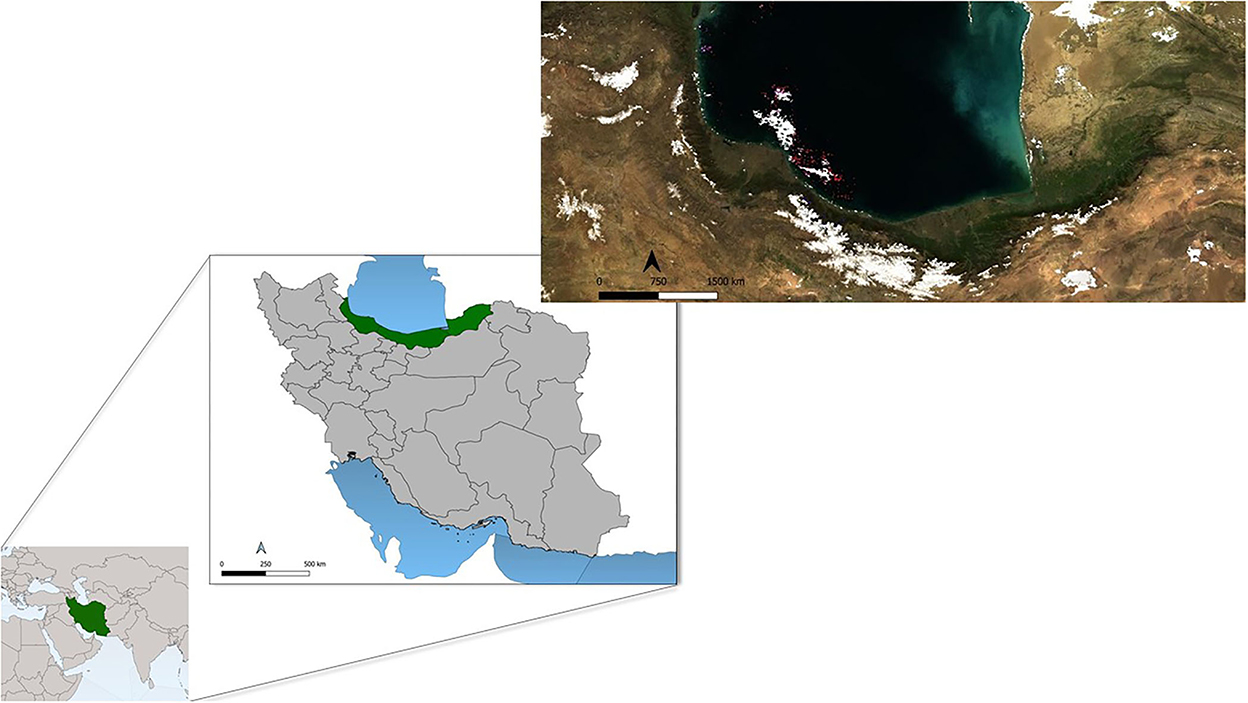
Figure 3. Map of Iran highlighting the three provinces in northern Iran include: Mazandaran, Gilan, and Golestan provinces using QGIS V.3.18 and true-color Sentinel-2 satellite imagery from https://www.sentinel-hub.com/.
3.2. Data collection
The agricultural data such as domestic production for rice, wheat, barley and lentil was obtained from the Ministry of Agriculture in Iran and the economic variables, like exchange rate, inflation and CPI and food prices were obtained from the statistical center of Iran, Central bank of Iran and FAO. Financial sanctions are derived from the US Congressional Research Service (Congressional Research Service., 2021) and published literature (Amuzegar, 1997; Torbat, 2005; Garshasbi and Yusefi, 2016; Heidary, 2018; Mahdiloo and Rezaei-Mirghaed, 2018; Rabi'I and Takrosta, 2021; Hejazi and Emamgholipour, 2022). Table 2 summarizes the data we used in the study. Sections 3.2.1 through 3.2.4 provide more detailed information on the consumer, economic, and climatic data used.
3.2.1. Price data
We used monthly prices from January 2010 to October 2021 for domestic rice, imported rice, domestic wheat and domestic lentils which derived from the statistical center of Iran (Figure 4). According to the Agricultural Planning, Economic and Rural Development Research Institute (APERDRI) the food basket for Iranian households highly depends on domestic production and availability of food, with 50% of energy supply in the food basket is provided by cereals—mostly wheat and rice. Beans, especially lentils, are important to the diet after wheat and rice (Agricultural Planning, 2016). Therefore, in this study we considered the domestic wheat, rice and lentils prices as well as imported rice prices because of the importance of rice in food security, sustainability and water resources in Iran.
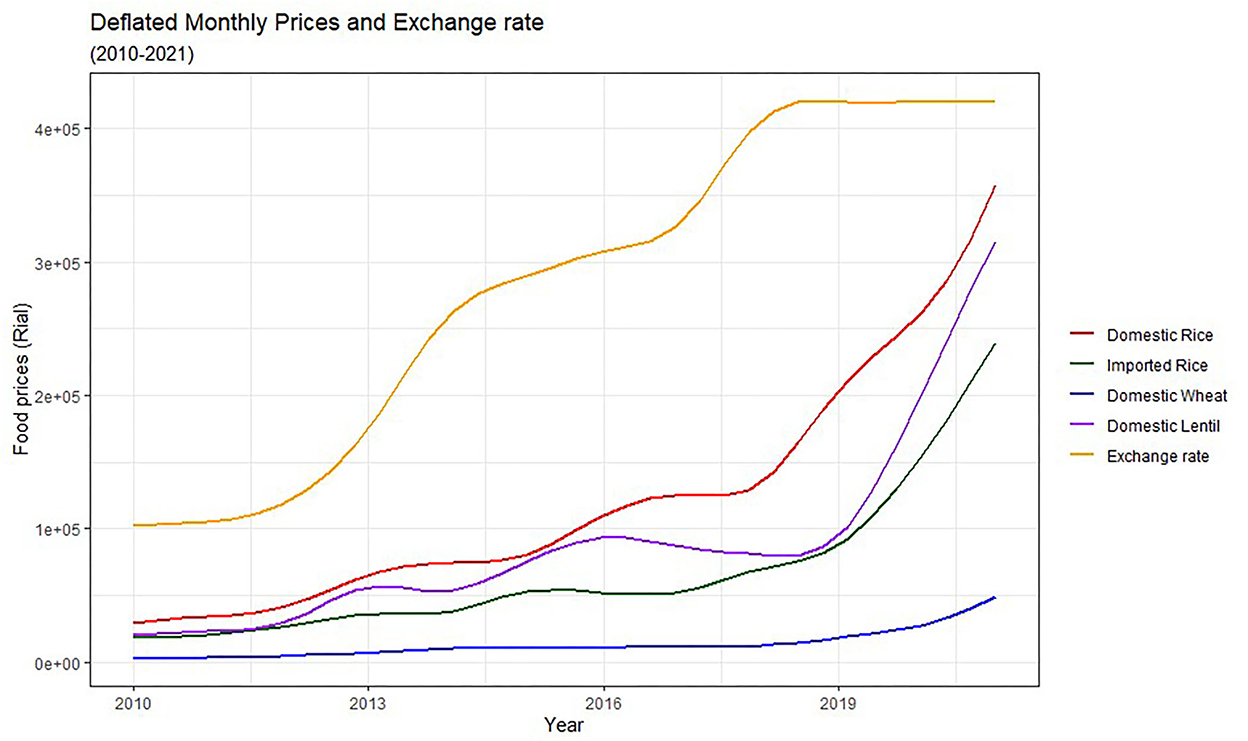
Figure 4. Monthly food price for domestic and imported rice, domestic wheat and domestic lentils along with exchange rate 2010–2021 (Source: https://www.amar.org.ir/).
3.2.2. Domestic production annually
Statistics of production, import, and export of agricultural products and foodstuffs were obtained from the Statistical Center of Iran (SCI). Restrictions on cultivable lands, the semi-desert position of Iran, the lack of mechanization of farms, and the imbalance of domestic supply and demand are the important factors of the high amount of food imports in Iran (Mardani Najafabadi et al., 2022) (the statistics of food imports are available in Supplementary Table S2). Therefore, efforts to increase the production of commodity crops are needed immediately (Iran's Crop Calendar as well as the statistics for crop production, yield and commodity crop areas, including wheat, rice and barley, are available in Supplementary Figure S1 and Supplementary Table S1. In January 2019, a deal among the Islamic Republic of Iran, Kazakhstan and the Russian Federation was struck to supply wheat via the Caspian Sea in order to increase the utilization of the Iranian wheat flour mills with excess capacity and, consequently, expand the Iranian exports of flour to third parties via the Persian Gulf (FAO, 2019). The Iranian private millers are not allowed to use the domestic wheat destined to supply the domestic market for these flour exports. All wheat imports are meant to be re-exported, while domestic wheat is only consumed in the country (FAO, 2019). We do not consider this complexity in our model, such that reported domestic production is assumed to be consumed in Iran and not exported. Figure 5 shows the annual domestic production for four commodity crops from 2010 to 2020, with detailed data on annual domestic production and imported commodities available in Supplementary Tables S1, S2.
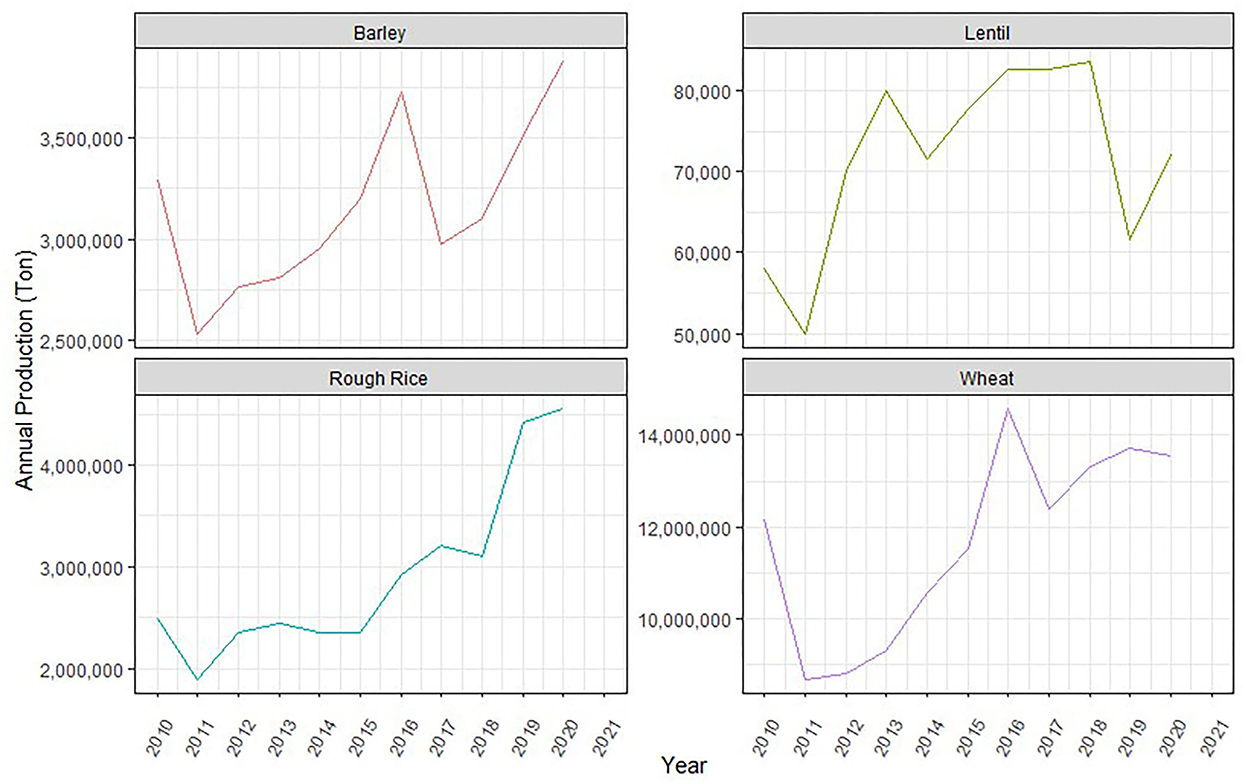
Figure 5. Annual domestic production for four commodity crops: rice, wheat, barley, and lentils [Source: Statistical Yearbooks, Ministry of Agriculture in Iran (https://maj.ir/)].
3.2.3. Consumer price index
The Consumer price index (CPI) is the measure of the average price changes of goods and services consumed by Iranian households (Karshenas and Pesaran, 1995) as well as the most common measure of inflation (Baker, 2016). CPI, as a tool for measuring general price level of goods and services consumed by households, is one of the best criteria for measuring changes in purchasing power of national currency (Rogoff, 1996). Deflating food prices with the CPI results in understating price affordability changes through time given the importance of food prices within the index (Alderman and Shively, 1996). The most important categories in the consumer price index in Iran are housing, water, electricity, gas and other fuels (29 percent of total weight) and food and beverages (28.5 percent of total weight). Others include: transport (11.97 percent); furnishings, household equipment and routine household maintenance (6 percent); clothing and footwear (6 percent) and health (5.5 percent). The smallest groups are recreation and culture; education; restaurants and hotels; communication; tobacco and miscellaneous services and goods [Statistical Center of Iran (SCI), 2021]. Figure 6 shows the monthly CPI rate from January 2011 to October 2021.
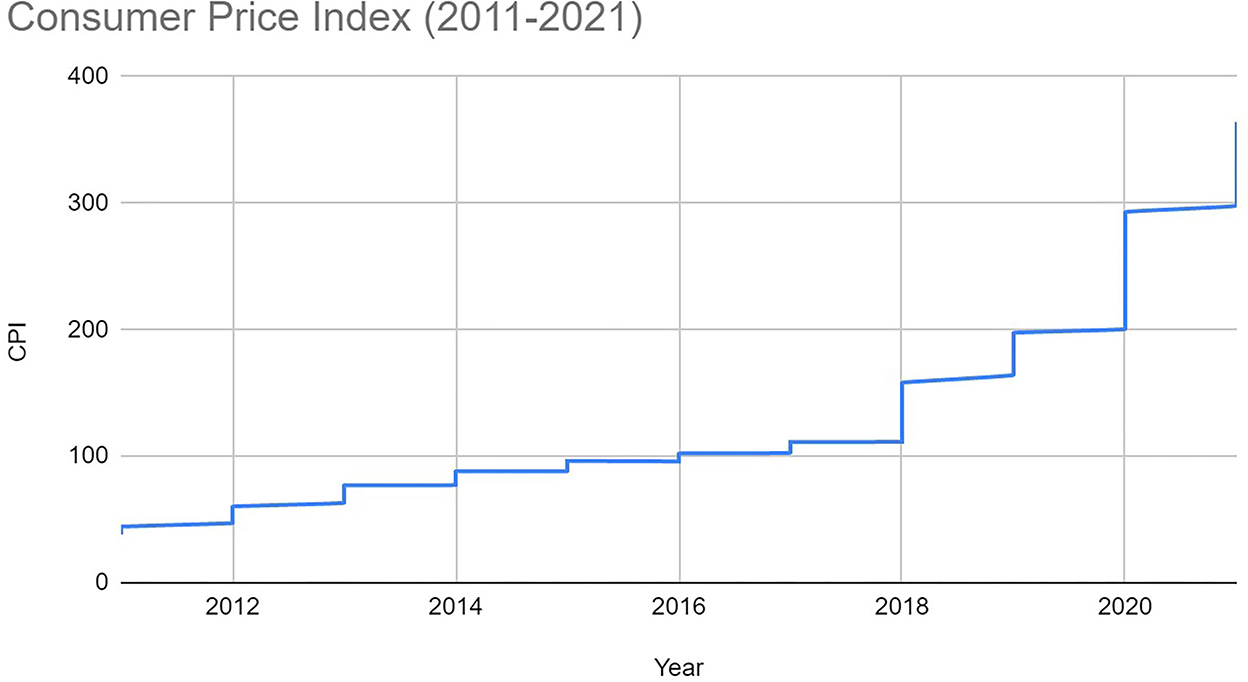
Figure 6. Monthly CPI in Iran 2011–2021 (Source: www.amar.org.ir).
3.2.4. Precipitation
This study used the monthly Climate Hazards group Infrared Precipitation with Stations (CHIRPS) data for the country of Iran for years 2008 to 2021 (Figure 7). The CHIRPS dataset builds on previous interpolation techniques and a high resolution, long term record of precipitation estimates based on infrared Cold Cloud Duration (CCD) observations. The CHIRPS algorithm (i) is built around a 0.05° climatology that incorporates satellite information to represent sparsely gauged locations, (ii) incorporates daily, pentadal, and monthly 1,981-present 0.05° CCD-based precipitation estimates, (iii) blends station data to produce a preliminary information product with a latency of about 2 days and a final product with an average latency of about 3 weeks, and (iv) uses a novel blending procedure incorporating the spatial correlation structure of CCD-estimates to assign interpolation weights (Funk et al., 2015). The density plots of average rainfall for the study area are also added to Supplementary Figure S2.
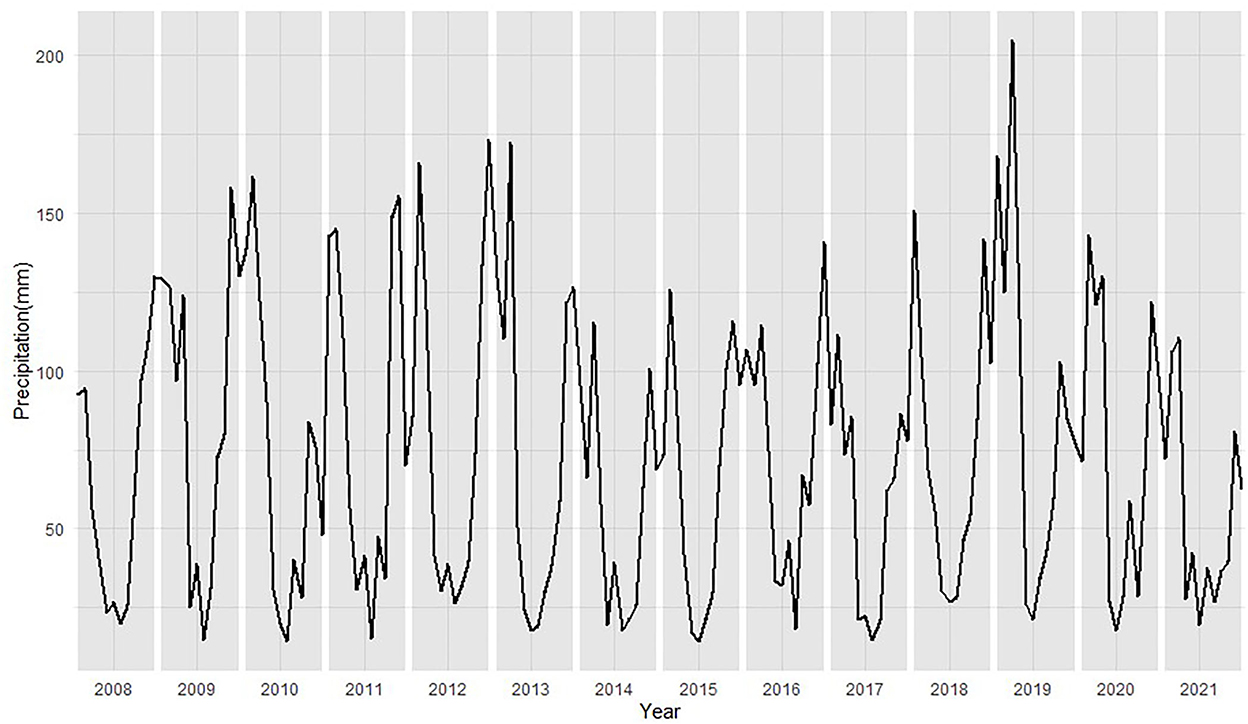
Figure 7. Monthly CHIRPS data spatially averaged across three northern provinces (Mazandaran, Gilan and Golestan) as the areas of interest in Iran from 2008 to 2021 for northern Iran.
3.3. Theoretical framework
Sharp increases in food prices also increase the number of people who fall into poverty, reduce the level and quality of nutrition, and decrease the consumption of non-food services such as education and healthcare, all of which adversely influence future growth of the global economy. In Iran several economic and climate indicators impact on food prices. Figure 8 shows the study framework with highlighting the variables included in the model. The variables in gray were initially considered but were ultimately not used in the final model. We considered economic measures, domestic production of commodity crops and climate change to analyze the food prices for domestic and imported rice, domestic wheat, and domestic lentils in Iran.
3.4. Statistical analysis
First, we deflated the food prices with CPI data and then the food prices were detrended with the use of Practical Numerical Math Functions (Borchers, 2022), then we analyzed the impact of sanctions and subsidy reform plans as well as the domestic production and finally we added the climate variables to see what impacts they had. Each of these are described below.
The monthly food prices were deflated to remove the impact of inflation by using the CPI as a deflator to adjust and normalize the food prices. Based on the information on CPI, we can adjust nominal prices in order to calculate real prices using the following formula (FEWS NET, 2009):
We then removed the trend using the Practical Numerical Math Functions (Pracma) in order to remove the effect of inflation over the period of interest on our price time series. By detrending, we can determine the probable relationship between food production, prices, and rainfall (Wu et al., 2007). In this study we used an additive method where the data is centered at zero. Detrended time series for food prices are added in Supplementary Figure S4.
A correlation matrix of detrended time series used to denote association between the food prices, inflation, international sanctions, domestic production and average monthly precipitation (Supplementary Figure S3).
To show the multicollinearity of the predictors, a Variance Inflation Factor (VIF) analysis was applied for the time series. The VIF of an explanatory variable indicates the strength of the linear relationship between the variable and the remaining explanatory variables (Forthofer et al., 2007). It can be used as a general diagnostic measure of collinearity and represents a considerably better approach than studying the simple correlation values. An important advantage of the VIF is that it indicates which coefficients have collinearity. The results of VIF were as follows (Table 3).
The predictors represented in Table 3 shows a good measure of Variance Inflation Factor (1 < VIF < 10) for use in the model. We used a simple linear equation with the food prices including domestic rice, imported rice, domestic wheat, and domestic lentils as our dependent variables, and sanctions, detrended domestic production for rice, wheat and lentils as well as the average monthly precipitation as our predictors. In the equation, Y is domestic food prices (rice, wheat, and lentils) along with the imported rice prices. β0 is intercept and β1 through β8 were the estimated regression coefficients (Supplementary Tables S3–S10). We used this equation to analyze the food prices based on the economic variables including sanctions along with the influences of domestic production and monthly precipitation.
Sanctions and reform plans were considered as dummy variables which were then separated into three different dummies based on the implemented date in the literature and the time period of this study. The first dummy variable was named “Sanction 1” which also included the subsidy reform plan. The second dummy variable was named “Sanction 2” and referred to the signing of the Joint Comprehensive Plan of Action (JCPOA) in July 2015. The third dummy variable was “Sanction 3” and highlighted the currency jumps after November 2018 due to economic sanctions (Table 1). In addition, barley was presented in Supplementary Tables S11, S12.
4. Results
Economic sanctions, particularly those that were imposed in 2018, were highly significant and increased domestic food prices in Iran (Figure 9). The sanctions imposed in 2011 and 2015 had significant negative impacts on food prices, with some financial relief and economic growth for a small period of time before 2018. We also found that domestic rice production has a negative impact on the prices of domestic and imported rice, wheat and lentils. The exchange rate also had a significantly negative correlation with prices for domestic and imported rice and domestic lentils. The currency exchange rate was an important determinant and critical to the price of food in Iran, demonstrating dependence on imports (Figure 9). When including the average monthly precipitation in the model, the results indicate no significant relationships between weather disturbances and food prices (Figure 10). These results also highlight the importance of sanctions (including the subsidy reform plan) and demonstrate that rice production, which is heavily irrigated, remains resilient to interannual rainfall changes, while also being an important driver of food prices. The exchange rate has a significant relationship with domestic rice and domestic lentil prices, but shows less significance for the imported rice price—highlighting the impact of the government subsidized dollar exchange rate. The detailed results for non-climatic and climate impacts are as follows.
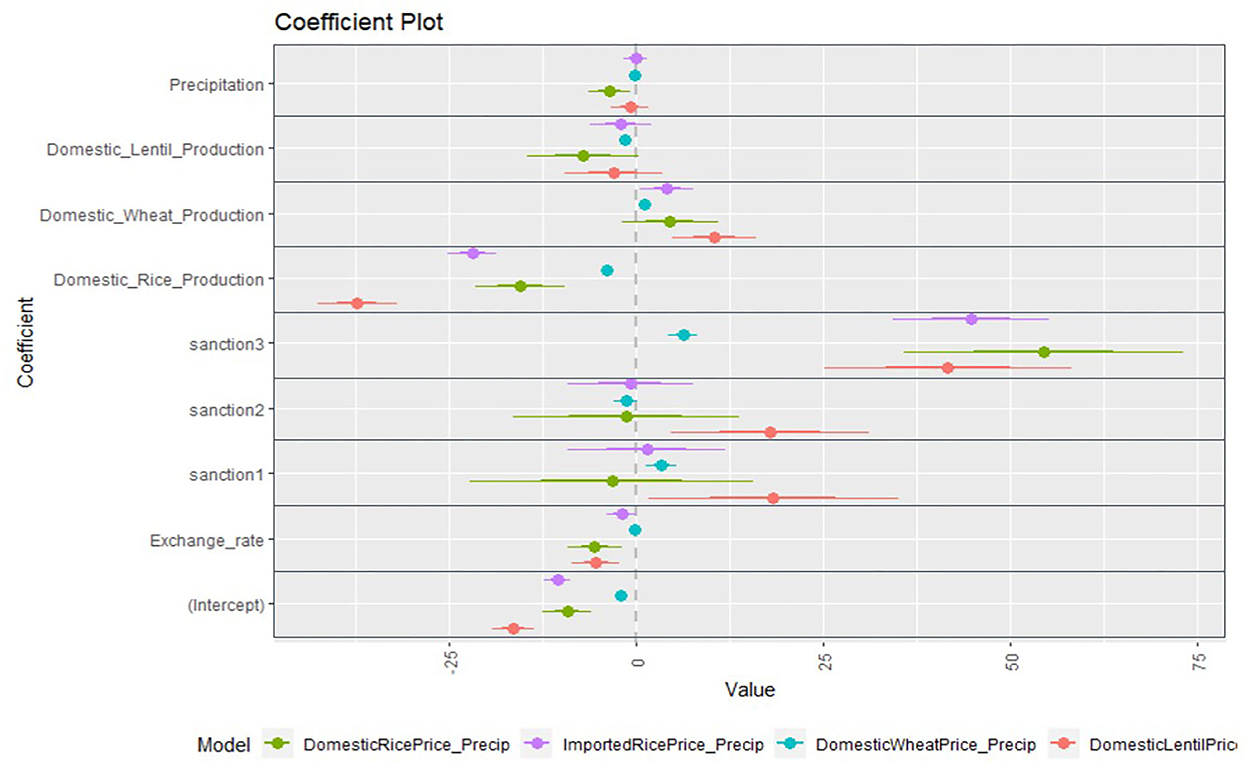
Figure 10. Linear regression results for detrended values including precipitation and based on the regression coefficients.
4.1. Non-climatic impacts on food prices
The results of linear regression for deflated and detrended drivers of food prices are presented in a coefficient plot (Figure 9). The coefficient value signifies how much the mean of the dependent variable changes given a one-unit shift in the independent variable while holding other variables in the model constant (Fahrmeir et al., 2009). All regressors are centered and scaled in a numeric matrix (details of the regression can be found in Supplementary Tables S3–S10) to allow comparability across models. The results show that the third sanction in 2018 and domestic rice production are highly significant in the model.
Sanction 3, imposed in 2018, led to food price increases. After 2018, there was a severe budget deficit and exchange rate crisis in the country. However, Sanction 1 and Sanction 2, which occurred in 2011 and 2015, respectively, demonstrated negative impacts on food prices. These secondary sanctions contributed to the shrinking of Iran's economy as its crude oil exports fell by more than 50% and it could not access foreign exchange assets held abroad. We found that these first two sanctions depressed food prices (Supplementary Tables S3–S10) as a result of reduced purchasing power.
The exchange rate also has a significantly negative effect on prices of rice (both domestic and imported) and lentils. Because of Iran's economic dependency and productive structure on imported goods and inputs, exchange rate movements can be considered as one of the important factors of inflation (Zaroki and Yousefi-Barfurushi, 2021), therefore increasing food prices in Iran.
4.2. Climate impacts on food prices
The average monthly precipitation is not significant in the model (Figure 10). However, the results indicate that including the weather variable highlights the influences of economic sanctions and rice production in domestic food prices (Supplementary Tables S7–S10). Since rice production in Iran is irrigated, it is more resilient to interannual variability of precipitation than wheat or lentils.
We also show that domestic rice production has a negative relationship with food prices. In addition, wheat production shows weak relationship with prices, confirming the importance of rice in our model and more specifically in the study area, which is the main region of producing rice domestically. We found that although Sanction 3 caused significant increases in the price of domestic and imported rice and domestic lentils, wheat was more resilient to the imposition of sanctions. Wheat price regression results were similar with and without precipitation included in the model.
5. Discussion
Iran has moderate levels of inequality compared to most countries (World Bank, 2019), with gradually increasing inequality and growing concentrations of wealth in cities leading to a corresponding impoverishment in the countryside. Inequality is exacerbated by sanctions (Kuznar, 2019). Much of the population in Iran is considered to be just above the poverty line. Therefore, a further deterioration of the economy would push more of the vulnerable population into poverty (Salehi-Isfahani, 2017). Although US officials stated that food and medications are not subject to the sanctions, due to the problems that sanctions have created for trade and transfers of goods, sale of oil, and international financial exchanges of Iran, the sharp rise in the exchange rate has pushed up the price of imported goods, including imported food (Congressional Research Service., 2021). Furthermore, as imported goods have become more expensive, demand for domestic food products increased, but due to the increase in imported agricultural input prices (e.g., livestock inputs such as animal corn as well as oil seeds, hybrid seeds, fertilizer and pesticides) the supply of domestic food products that use these inputs has not been able to meet the demands (Hejazi and Emamgholipour, 2022). The lack of affordable food is likely to exacerbate food insecurity in low income Iranian people and make them more prone to chronic disease (Mohammadi Nasrabadi et al., 2014). This confirms the results of the study which indicate sanctions impacts on increasing food prices in Iran. Mahmoudinia (2021) shows that monetary policy, exchange rate and currency constraints affect food price inflation and are strongly linked to economic sanctions which also align with the results of this study.
Ninety percent of Iran is comprised of arid and semi-arid regions, with more than half of the country's water needs procured from aquifers. Our results showed that the average precipitation in the Caspian Sea coast was only marginally relevant to local food prices, despite the importance of this region to food production (Afzali et al., 2020). Iran's rising food demand is pushing against the limits of its own production capacity, which faces tight constraints from geography and climate (USDA, 2017).2 Therefore, improving the climate will increase the country's economic potential and reduce costs, while adverse climate conditions will worsen the country's economic situation and, consequently, increase costs (Vatankhah et al., 2020).
Results showed that domestic rice production has a negative relationship with food prices. Rice provides the main food supply to more than 50% of the population in Iran and increasing rice production is therefore an effective method to promote food security at the national-level (Zamanialaei et al., 2022). Rice production is highly affected by government policies, like the guaranteed purchase price. Approved in 1999, the guaranteed purchase of crops is the most important policy of the agricultural sector in Iran. The guaranteed purchase policy obliges the government to support the production of basic agricultural crops by guaranteeing the purchase of domestically produced wheat, rice and barley every year at a set price (Jafari Lisar et al., 2019). These policies resulted in some unwanted outcomes, such as changing the prices and production of other crops (e.g., wheat, barley, lentils), as well as working against the general objective of self-sufficiency in agricultural production (Najafi and Bakhshoodeh, 2002).
Although the experience of Iran with sanctions is unique, the analysis in this paper illuminates the potential harms and economic isolation that financial sanctions bring to countries and their populations. The impact of sanctions on the poor and vulnerable has been large, but the international community has not been able to affect the governments' policies or its decision making. Therefore, a need exists to transform sanctions from a “weapon” and punitive tool into a pressure mechanism that provides incentives to governments to carry out reforms. To ensure greater food security, Iran allocates subsidized foreign exchange to importing critical foods such as wheat and rice, promoting the optimum use of scarce inputs (e.g., livestock inputs, seeds, fertilizers and pesticides) in the agricultural sector, and relies on domestic production for the purpose of food security (Bodetti, 2019).
6. Conclusions
We show in this paper that during the past 10 years, irrigated rice production has underpinned agricultural production and provided stability to food prices in Iran. The first two US sanctions that were imposed in 2012 and 2015 actually reduced overall food prices, corresponding with a contraction of the broader economy. The third US sanction in 2018, however, caused further reductions in the ability of the government to import food, setting off an inflationary spiral which has affected the prices of both imported and domestic goods. We showed that despite being precipitation and temperature sensitive, wheat and lentil prices were not affected by monthly changes in precipitation, despite there being low rainfall totals in 2014–2016. All three sanction periods, but particularly the third, were more important drivers of Iranian food prices than weather variability. Weather, which is likely to become more unstable and less suitable for agricultural production in Iran with climate change, was not as statistically important as financial sanctions. In essence, while climate change may be a problem for food production, importation, and prices in the near to long term, the last decade's food price stability is driven by sanctions.
Economic and environmental issues confronting modern food systems threaten global long-term food security and natural resource management (El Bilali et al., 2019). As inflationary pressures rise, vulnerable populations in the Middle East and North Africa region are likely to remain food insecure. Furthermore, the Middle East countries are very vulnerable to climate change effects (Mansouri Daneshvar et al., 2019). Among the Middle East countries, Iran will experience an increase of 2.6°C in mean temperatures and a 35% decline in precipitation in the next decades (NCCOI, 2014). Based on recent scientific reports, an increased risk of drought will threaten water and food security especially for people who live in the highly populated cities of Iran (Karandish and Mousavi, 2018). Therefore, decision-makers should modify food policies by supporting transitions to sustainable energy, improved natural resource management and agricultural practices while helping to diversify and build a resilient economy. Also, restructuring guaranteed prices for specific crops (e.g., rice and wheat) in specific regions to reflect resource availability could promote new cropping patterns more appropriate to land and water conditions.
Alongside rising prices, sanctions served to disrupt the supply chains on which the importation and domestic production of humanitarian goods, like food, depend (Batmanghelidj, 2022). Food price hikes, subsidy cuts and high levels of un- and under-employment due to economic downturn have limited the population's economic access to nutritious food in Iran [World Food Programme (WFP)., 2016]. High levels of inflation, coupled with population growth, urbanization and a constraint on food production are likely to push more people into food insecurity (Layani et al., 2020). Future work must consider financial sanctions, including expanding to consider the impact of conflicts on sanctions and food production, when determining impacts on food prices and thus food security for human populations. Geospatial products of long term climatic and agricultural variables exist, meaning now is the time to assess these multidisciplinary impacts—from policy and economic to sociocultural and international relations—in combination with spatially-explicit climatic and biophysical data.
Data availability statement
The datasets presented in this study can be found in online repositories. The names of the repository/repositories and accession number(s) can be found in the article/Supplementary material.
Author contributions
Data collection was conducted and the first draft of the manuscript was written by MZ. The material preparation and data analysis were performed by MZ, MB, JM, and JF. All authors contributed to the study conception and design, commented on previous versions of the manuscript, read, and approved the final manuscript.
Funding
The authors acknowledge the partial funding for this work was provided by internal research funds at Miami University and USDA NIFA grant number 2020-70001-31289.
Acknowledgments
We are thankful to our colleague, Dr. Jing Li (of the Farmer School of Business at Miami University) who provided expertise that greatly assisted the research.
Conflict of interest
During the drafting and submission stage of the manuscript, JF was employed by Miami University. During the review, revision, and acceptance stages of the manuscript, JF is employed by ISciences, L.L.C., Burlington, Vermont, United States.
The remaining authors declare that the research was conducted in the absence of any commercial or financial relationships that could be construed as a potential conflict of interest.
Publisher's note
All claims expressed in this article are solely those of the authors and do not necessarily represent those of their affiliated organizations, or those of the publisher, the editors and the reviewers. Any product that may be evaluated in this article, or claim that may be made by its manufacturer, is not guaranteed or endorsed by the publisher.
Supplementary material
The Supplementary Material for this article can be found online at: https://www.frontiersin.org/articles/10.3389/fsufs.2022.998235/full#supplementary-material
Footnotes
1. ^https://www.sanctionsmap.eu/#/main
2. ^https://www.ers.usda.gov/webdocs/outlooks/84408/aes-100.pdf?v=45.8
References
Afzali, R., Ghareh-Beygi, M., and Yazdanpanah, D. Q. (2020). Climate changes and food policies: economic pathology. Clim. Risk Manag. 30, 100249. doi: 10.1016/j.crm.2020.100249
Agricultural Planning Economic and Rural Development Research Institute. (2016). Analysis and Comparison of Iran's Favorable Food Basket with the Situation of Food Production of Agricultural Products during the Years of the Sixth Development Plan and Horizon 1404. Available online at: http://www.agri-peri.ac.ir/ (accessed April 14, 2022).
Alderman, H., and Shively, G. (1996). Economic reform and food prices: evidence from markets in Ghana. World Dev. 24, 521–534. doi: 10.1016/0305-750X(95)00146-4
Ashraf, S., Nazemi, A., and AghaKouchak, A. (2021). Anthropogenic drought dominates groundwater depletion in Iran. Scient. Rep. 11, 9135. doi: 10.1038/s41598-021-88522-y
Atashi, N., Rahimi, D., Goortani, B. M., Duplissy, J., Vuollekoski, H., Kulmala, M., et al. (2019). Spatial and temporal investigation of dew potential based on long-term model simulations in Iran. Water 11, 2463. doi: 10.3390/w11122463
Baker, D. (2016). Getting Prices Right: Debate Over the Consumer Price Index: Debate Over the Consumer Price Index. New York, NY: Routledge. doi: 10.4324/9781315502656
Batmanghelidj, E. (2022). The Inflation Weapon: How American Sanctions Harm Iranian Households. Sanctions and Security Research Project. Available online at: https://sanctionsandsecurity.org/publications/the-inflation-weapon-how-american-sanctions-harm-iranian-households/ (accessed May 31, 2022).
Behzadifar, M., Behzadifar, M., Abdi, S. H., Malekzadeh, R., Arab Salmani, M., Ghoreishinia, G. H., et al. (2016). Prevalence of food insecurity in Iran: a systematic review and meta-analysis. Arch. Iran. Med. 19, 288–294. doi: 10.0161904/AIM.0012
Birgani, R., Kianirad, A., Shab-Bidar, S., Djazayeri, A., Pouraram, H., and Takian, A. (2022). Climate change and food price: a systematic review and meta-analysis of observational studies, 1990-2021. Am. J. Clim. Change 11, 103–132. doi: 10.4236/ajcc.2022.112006
Bodetti, A. (2019). Iran Struggles With Food Security Amid Sanctions. LobeLog. Available online at: https://lobelog.com/iran-struggles-with-food-security-amid-sanctions/
Borchers, H. W. (2022). R Package Pracma Manual. Available online at: https://github.com/hwborchers/pracma-manual (accessed April 19, 2022).
Brown, M. E., and Kshirsagar, V. (2015). Weather and international price shocks on food prices in the developing world. Glob. Environ. Change 35, 31–40. doi: 10.1016/j.gloenvcha.2015.08.003
Central Bank of Iran (CBI). (2021). CPI and Inflation Rate in Iran. Available online at: https://www.cbi.ir/Inflation/Inflation_en.aspx (accessed December 28, 2021).
Congressional Research Service. (2021). Iran Sanctions. Available online at: https://sgp.fas.org/crs/mideast/RS20871.pdf (accessed January 02, 2022).
Devereux, S. (2016). Social Protection and Safety Nets in the Middle East and North Africa. Institute of Development Studies. IDS research report, Issue 80. Available online at: https://opendocs.ids.ac.uk/opendocs/handle/20.500.12413/8976
El Bilali, H., Callenius, C., Strassner, C., and Probst, L. (2019). Food and nutrition security and sustainability transitions in food systems. Food Energy Secur. 8, e00154. doi: 10.1002/fes3.154
Fahrmeir, L., Kneib, T., and Lang, S. (2009). “Lineare regressionsmodelle,” in Regression: Modelle, Methoden und Anwendungen, Statistik und ihre Anwendungen, eds L. Fahrmeir, T. Kneib, and S. Lang (Berlin, Heidelberg: Springer), 59–188. doi: 10.1007/978-3-642-01837-4_3
FAO (2019). GIEWS - Global Information and Early Warning System on Food and Agriculture | Country Brief Iran (Islamic Republic Of). Available online at: https://www.fao.org/giews/countrybrief/country/IRN/pdf_archive/IRN_Archive.pdf (accessed April 18, 2022).
FAO (2020). Coronavirus May Disrupt Food Supply Chains, Vulnerable Households to Feel Worst Impact: FAO in the Islamic Republic of Iran. FAO in the Islamic Republic of Iran. Available online at: https://www.fao.org/iran/news/detail-events/zh/c/1271192/ (accessed December 28, 2021).
FAO (2021a). FAOSTAT. Available online at: https://www.fao.org/faostat/en/#data/FS (accessed December 28, 2021).
FAO (2021b). The Impact of Disasters and Crises on Agriculture and Food Security: 2021. FAO. Available online at: https://www.fao.org/3/cb3673en/cb3673en.pdf
FAO IFAD, UNICEF, WFP, and WHO. (2021). The State of Food Security and Nutrition in the World 2021. Transforming Food Systems for Food Security, Improved Nutrition and Affordable Healthy Diets For All. Rome: FAO. doi: 10.4060/cb4474en
Fatahi Ardakani, A., Sakhi, F., Bostan, Y., and Rezvani, M. (2022). Assessing the effect of climate change and food price index on food security of urban households in Iran. J. Agric. Econ. Dev. 36, 249–263. doi: 10.22067/jead.2021.71352.1060
FEWS NET (2009). Adjusting Prices for Inflation and Creating Price Indices. FEWS NET Markets Guidance, No 3. USAID. Available online at: https://fews.net/sites/default/files/MT%20Guidance_Price%20Adjustment%20for%20Inflation_No%203_En.pdf (accessed May 3, 2022).
Forthofer, R. N., Lee, E. S., and Hernandez, M. (2007). “13 - Linear regression,” in Biostatistics, 2nd Edn., eds R. N. Forthofer, E. S. Lee, and M. Hernandez (San Diego, CA: Academic Press), 349–86. doi: 10.1016/B978-0-12-369492-8.50018-2
Funk, C. H., Peterson, P., Landsfeld, M., Pedreros, D., Verdin, J., Shukla, S. H., et al. (2015). The climate hazards infrared precipitation with stations—a new environmental record for monitoring extremes. Sci. Data 2, 150066. doi: 10.1038/sdata.2015.66
Garshasbi, A., and Yusefi, M. (2016). Assessment of international sanctions on Iranian macroeconomic variables. J. Res. Econ. Model. 7, 129–182. doi: 10.18869/acadpub.jemr.7.25.129
Harrigan, J. (2014). “Reforming social safety nets,” in The Political Economy of Arab Food Sovereignty, ed J. Harrigan (London: Palgrave Macmillan UK), 197–217. doi: 10.1057/9781137339386_8
Heidary, K. (2018). Evaluation the impact of US sanctions on food security in Iranian households. Soc. Secur. J. 14, 35–52. Available online at: http://qjo.ssor.ir/article_83506.html?lang=en
Hejazi, J., and Emamgholipour, S. (2022). The effects of the re-imposition of US sanctions on food security in Iran. Int J Health Policy Manag. 11, 651–657. doi: 10.34172/ijhpm.2020.207
Iran Economy News (2021). Agricultural Production In Iran (). IRIB News Agency. Available online at: https://www.iribnews.ir/fa/news/3277186 (accessed January 20, 2022).
Iran Watch. (2019). U.N.-EU Sanctions Tally. Available online at: https://www.iranwatch.org/sanctions (accessed January 08, 2019).
Islamic Parliament Research Center (IPRC). (2019). Investigation and Analysis of Flood Events in April 2019. Rainfall Status and Reservoirs of the Country's Dams. Available online at: https://rc.majlis.ir/fa/report/show/1142662 (accessed December 28, 2021).
Jafari Lisar, N., Keramatzadeh, A., and Joulaei, R. (2019). The impact of government support policies of rice supply in Iran. J. Agri. Econom. Res. 11, 17–38. Available online at: https://www.sid.ir/paper/158795/en
Karandish, F., and Mousavi, S. (2018). Climate change uncertainty and risk assessment in Iran during twenty-first century: evapotranspiration and green water deficit analysis. Theoret. Appl. Climatol. 131, 777–791. doi: 10.1007/s00704-016-2008-2
Karbasi, A., and Sayyadi, CH. (2015). Effects of climate change on food expenditures of rural households in Iran. Int. J. Agri. Manag. Develop. 6, 225–233. Available online at: https://ijamad.rasht.iau.ir/article_523439.html
Karshenas, M., and Pesaran, M. H. (1995). Economic reform and the reconstruction of the Iranian economy. Middle East J. 49, 89–111.
Kiani Ghalehsard, S., Shahraki, J., Akbari, A., and Sardar shahraki, A. (2020). Investigating the effects of climate change on food security of Iran. J. Nat. Environ. Hazards 8, 19–40. doi: 10.22111/jneh.2018.24170.1380
Kuznar, L. A. (2019). Iran Inequality Report. NSI Aggrieved Populations Reports. October 2019. Available online at: https://nsiteam.com/social/wp-content/uploads/2019/10/NSI-Aggrieved-Populations-Reports_Iran-Country-Report_Final.pdf
Layani, G., Bakhshoodeh, M., Aghabeygi, M., Kurstal, Y., and Viaggi, D. (2020). The impact of food price shocks on poverty and vulnerability of urban households in Iran. Bio Based Appl. Econ. 9, 109–125. doi: 10.13128/bae-8892
Madani, K., AghaKouchak, A., and Mirchi, A. (2016). Iran's socio-economic drought: challenges of a water-bankrupt nation. Iran. Stud. 49, 997–1016. doi: 10.1080/00210862.2016.1259286
Mahdiloo, A., and Rezaei-Mirghaed, M. (2018). Estimating the impact of economic sanctions on price levels in the context of economic resilience; time varying parameter approach (Tvp). Econ. Strat. 7, 5–50.
Mahmoudinia, D. (2021). The asymmetric effects of monetary policy, currency crises and oil price on food inflation in Iran: an application of quantile regression. Macroecon. Finan. Emerg. Market Econ. 1–23. doi: 10.1080/17520843.2021.2005926
Mansouri Daneshvar, M. R., Ebrahimi, M., and Nejadsoleymani, H. (2019). An overview of climate change in Iran: facts and statistics. Environ. Syst. Res. 8, 7. doi: 10.1186/s40068-019-0135-3
Mardani Najafabadi, M., Sabouni, M., Azadi, H., and Taki, M. (2022). Rice production energy efficiency evaluation in North of Iran; application of robust data envelopment analysis. Cleaner Eng. Technol. 6, 100356. doi: 10.1016/j.clet.2021.100356
Mbow, C., Rosenzweig, C., Barioni, L., Benton, T., Herrero, M., Krishnapillai, M., et al. (2019). “Food security,” in Climate Change and Land: An IPCC Special Report on Climate Change, Desertification, Land Degradation, Sustainable Land Management, Food Security, and Greenhouse Gas Fluxes in Terrestrial Ecosystems, eds P. R. Shukla, J. Skea, E. Calvo Buendia, V. Masson-Delmotte, and H. -O. Pörtner (Intergovernmental Panel on Climate Change), 437–550. Available online at: https://www.ipcc.ch/site/assets/uploads/sites/4/2020/06/IPCCJ7230-Land_SM5_200226.pdf
Mesgaran, M. B., Madani, K., Hashemi, H., and Azadi, P. (2017). Iran's land suitability for agriculture. Sci. Rep. Int. Dev. Res. Cent. Can. 7, 7670. doi: 10.1038/s41598-017-08066-y
Ministry of Agriculture-Jihad in Iran Yearbook (2019). Available online at: https://www.maj.ir
Mohammadi Nasrabadi, F., Omidvar, N., Khoshfetrat, M. R., and Kolahdooz, F. (2014). Household food insecurity in the Islamic Republic of Iran: a systematic review and meta-analysis. Eastern Mediterr. Health J. 20, 698–706. doi: 10.26719/2014.20.11.698
Najafi, B., and Bakhshoodeh, M. (2002). Effectiveness of government protective policies on rice production in Iran. Res. Agric. Appl. Econ. doi: 10.22004/ag.econ.24922
NCCOI (2014). Third National Communication to UNFCCC. National Climate Change Office of Iran. http://climate-change.ir. Available online at: https://unfccc.int/sites/default/files/resource/ThirdNationalcommunicationIRAN.pdf
Rabi'I, H., and Takrosta, M. (2021). Investigating the effects of US economic sanctions on the rural economy in Iran. Serd. 10, 199–214. Available online at: http://dorl.net/dor/20.1001.1.23222131.1400.10.37.10.2
Ray, D. K., Gerber, J. S., MacDonald, G. K., and West, P. C. (2015). Climate variation explains a third of global crop yield variability. Nat. Commun. 6, 5989. doi: 10.1038/ncomms6989
Sadeghi, A., and Tayebi, S. K. (2018). Effects of international sanctions and other determinants on iran's inflation rate (1981–2014). Iranian J. Econom. Res. 23, 33–57. doi: 10.22054/ijer.2018.8825
Salamatbakhsh, F. (2020). Iran Subsidy Plan. The Islamic Republic News Agency. Available online at: irna.ir/xjC3hW (accessed January 20, 2022).
Salehi-Isfahani, D. (2017). Poverty and income inequality in the islamic republic of Iran. Revue Int. Études Dév. 229, 113–36. doi: 10.3917/ried.229.0113
Shakeri, A., Mohammadi, T., and Rajabi, F. (2015). Mark-up impact on inflation in Iran‘s economy. J. Econom. Res. 15, 37–60. Available online at: https://joer.atu.ac.ir/article_1822.html?lang=en
Sharifi, M. (2021). Severe Drought in Golestan Province (). Mehr News Agency. Available online at: https://www.mehrnews.com/news/5302919 (accessed April 17, 2022).
Statistical Center of Iran (SCI). (2019). Area of Forests, Pastures, and Desert Phenomena in Iran. Available online at: https://www.amar.ir (accessed December 28, 2021).
Statistical Center of Iran (SCI). (2021). Rate of Economic Growth in Iran. Statistical Center of Iran (SCI). Available online at: https://www.amar.org.ir/news/ID/13081 (accessed December 28, 2021).
The World Bank (2021). Iran Overview: Development News, Research, Data. Available online at: https://www.worldbank.org/en/country/iran/overview#1 (accessed December 28, 2021).
Torbat, A. (2005). Impacts of the US Trade and Financial Sanctions on Iran. World Econ. 28, 407–434. doi: 10.1111/j.1467-9701.2005.00671.x
Trading Economics. (2021). Iran Food Inflation. Available online at: https://tradingeconomics.com/iran/food-inflation (accessed December 28, 2021).
Tutunchi, H., Ebrahimi-Mameghani, M., Asghari-Jafarabadi, M., Farrin, N., Tabrizi, S., Vaghef-Mehrabany, E., et al. (2020). Is the modified household food security survey (HFSS) questionnaire a practical tool for screening food insecurity? Evidence from Northwest of Iran. BMC Public Health 20, 883. doi: 10.1186/s12889-020-09014-8
USDA (2017). Developments in Iran's Agriculture Sector and Prospects for U.S. Trade. A report from the Economic Research Service by Mesbah Motamed, July 2017. Available online at: https://www.ers.usda.gov/webdocs/outlooks/84408/aes-100.pdf?v=45.8
Vaghefi, S. A., Keykhai, M., Jahanbakhshi, F., Sheikholeslami, J., Ahmadi, A., Yang, H., et al. (2019). The future of extreme climate in Iran. Sci. Rep. 9, 1464. doi: 10.1038/s41598-018-38071-8
Vatankhah, T., Moosavi, S. N., and Majdzadeh Tabatabaei, S. H. (2020). The economic impacts of climate change on agriculture in Iran: a CGE model analysis. Energy Sources Part A Recov. Utiliz. Environ. Effects 42, 1935–1949, doi: 10.1080/15567036.2019.1604903
World Bank (2019). Gini index - Iran. World Bank. Available online at: https://data.worldbank.org/indicator/SI.POV.GINI?locations=IR
World Bank (2021). Iran's Economic Update - April 2021. World Bank. Available online at: https://www.worldbank.org/en/country/iran/publicaion/economic-update-april-2021
World Food Programme (WFP). (2016). Iran - Food and Nutrition Security in Iran. Availoable online at: https://www.wfp.org/publications/iran-food-and-nutrition-security-july-2016 (accessed July 2016).
Wu, Z. H., Huang, N. E., Long, S. R., and Peng, C. H. K. (2007). On the trend, detrending, and variability of nonlinear and nonstationary time series. Proc. Nat. Acad. Sci. U.S.A. 104, 14889–14894. doi: 10.1073/pnas.0701020104
Zamanialaei, M., McCarty, J. L., Fain, J. J., and Michael, R. Hughes. (2022). Understanding the perceived indicators of food sovereignty and food security for rice growers and rural organizations in Mazandaran Province, Iran. Agric Food Secur. 11, 50. doi: 10.1186/s40066-022-00386-1
Zaroki, S. H., and Yousefi-Barfurushi, A. (2021). Free-market exchange rate and rigidity of prices in Iran by nonlinear ARDL approach. Jordan J. Econom. Sci. 8, 47–61. Available online at: https://journals.ju.edu.jo/JJES/article/view/106021
Keywords: international sanctions, food inflation, staple food prices, commodity crops, precipitation
Citation: Zamanialaei M, Brown ME, McCarty JL and Fain JJ (2023) Weather or not? The role of international sanctions and climate on food prices in Iran. Front. Sustain. Food Syst. 6:998235. doi: 10.3389/fsufs.2022.998235
Received: 19 July 2022; Accepted: 21 December 2022;
Published: 18 January 2023.
Edited by:
Md. Shakhawat Hossain, Northwest A&F University, ChinaReviewed by:
Md. Ghulam Rabbany, Sher-e-Bangla Agricultural University, BangladeshShah Fahad, Leshan Normal University, China
Copyright © 2023 Zamanialaei, Brown, McCarty and Fain. This is an open-access article distributed under the terms of the Creative Commons Attribution License (CC BY). The use, distribution or reproduction in other forums is permitted, provided the original author(s) and the copyright owner(s) are credited and that the original publication in this journal is cited, in accordance with accepted academic practice. No use, distribution or reproduction is permitted which does not comply with these terms.
*Correspondence: Maryam Zamanialaei,  zamanialaeim@berkeley.edu
zamanialaeim@berkeley.edu
 Maryam Zamanialaei
Maryam Zamanialaei